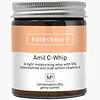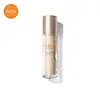What's inside
What's inside
 Key Ingredients
Key Ingredients

 Benefits
Benefits

 Concerns
Concerns

 Ingredients Side-by-side
Ingredients Side-by-side

Water
Skin ConditioningBis-Ethylhexyloxyphenol Methoxyphenyl Triazine
Skin ConditioningNiacinamide
SmoothingCoco-Caprylate
EmollientButyloctyl Salicylate
Skin ConditioningGlyceryl Stearate
EmollientPolyglyceryl-6 Stearate
EmollientMicrocrystalline Cellulose
AbsorbentSodium Ascorbyl Phosphate
AntioxidantLactic Acid
BufferingCetyl Alcohol
EmollientTocopherol
AntioxidantGlycerin
HumectantSodium Anisate
AntimicrobialSodium Levulinate
Skin ConditioningGlyceryl Caprylate
Emollient3-O-Ethyl Ascorbic Acid
Skin ConditioningPolyglyceryl-6 Behenate
Emulsion StabilisingRosa Canina Fruit Extract
AstringentGellan Gum
Xanthan Gum
EmulsifyingSodium Phytate
Citrus Limon Fruit Oil 0.475%
AstringentWater, Bis-Ethylhexyloxyphenol Methoxyphenyl Triazine, Niacinamide, Coco-Caprylate, Butyloctyl Salicylate, Glyceryl Stearate, Polyglyceryl-6 Stearate, Microcrystalline Cellulose, Sodium Ascorbyl Phosphate, Lactic Acid, Cetyl Alcohol, Tocopherol, Glycerin, Sodium Anisate, Sodium Levulinate, Glyceryl Caprylate, 3-O-Ethyl Ascorbic Acid, Polyglyceryl-6 Behenate, Rosa Canina Fruit Extract, Gellan Gum, Xanthan Gum, Sodium Phytate, Citrus Limon Fruit Oil 0.475%
Water
Skin ConditioningEthylhexyl Olivate
Skin ConditioningGlycerin
HumectantPentylene Glycol
Skin ConditioningIsononyl Isononanoate
EmollientCetyl Alcohol
EmollientEthylhexyl Palmitate
EmollientPearl Powder
Niacinamide
SmoothingDiheptyl Succinate
EmollientGlyceryl Stearate
EmollientSilica
AbrasiveGlyceryl Behenate
EmollientPortulaca Oleracea Extract
Skin ConditioningSclerotium Gum 1%
Emulsion StabilisingSodium Hyaluronate Crosspolymer
HumectantJojoba Esters
EmollientSclerocarya Birrea Seed Oil
HumectantTocopheryl Acetate
Antioxidant3-O-Ethyl Ascorbic Acid
Skin ConditioningDecyl Glucoside
CleansingPropanediol
SolventPhaseolus Radiatus Seed Extract
Skin ConditioningHydrolyzed Sodium Hyaluronate
Skin ConditioningHelianthus Annuus Seed Wax
Skin ConditioningCeteth-20
CleansingSteareth-20
CleansingSqualane
EmollientCapryloyl Glycerin
Myrciaria Dubia Fruit Extract
Skin ConditioningButylene Glycol
HumectantC13-14 Isoparaffin
EmollientBenzoic Acid
MaskingPolysorbate 20
EmulsifyingStearyl Alcohol
EmollientDimethyl Isosorbide
SolventPolysorbate 80
EmulsifyingSorbitan Caprylate
EmulsifyingXanthan Gum
EmulsifyingAcacia Decurrens Flower Wax
EmollientTetradecane
PerfumingPolyglycerin-3
HumectantLeuconostoc/Radish Root Ferment Filtrate
AntimicrobialPEG-75 Stearate
Lecithin
EmollientHea/Sodium Acryloyldimethyltaurate/Steareth-20 Methacrylate Copolymer
Emulsion StabilisingPanthenol
Skin ConditioningPhenoxyethanol
PreservativePolyglutamic Acid
Skin ConditioningSodium Hydroxide
BufferingAcetyl Tetrapeptide-11
Skin ConditioningAcetyl Tetrapeptide-9
Skin ConditioningEthylhexylglycerin
Skin ConditioningWater, Ethylhexyl Olivate, Glycerin, Pentylene Glycol, Isononyl Isononanoate, Cetyl Alcohol, Ethylhexyl Palmitate, Pearl Powder, Niacinamide, Diheptyl Succinate, Glyceryl Stearate, Silica, Glyceryl Behenate, Portulaca Oleracea Extract, Sclerotium Gum 1%, Sodium Hyaluronate Crosspolymer, Jojoba Esters, Sclerocarya Birrea Seed Oil, Tocopheryl Acetate, 3-O-Ethyl Ascorbic Acid, Decyl Glucoside, Propanediol, Phaseolus Radiatus Seed Extract, Hydrolyzed Sodium Hyaluronate, Helianthus Annuus Seed Wax, Ceteth-20, Steareth-20, Squalane, Capryloyl Glycerin, Myrciaria Dubia Fruit Extract, Butylene Glycol, C13-14 Isoparaffin, Benzoic Acid, Polysorbate 20, Stearyl Alcohol, Dimethyl Isosorbide, Polysorbate 80, Sorbitan Caprylate, Xanthan Gum, Acacia Decurrens Flower Wax, Tetradecane, Polyglycerin-3, Leuconostoc/Radish Root Ferment Filtrate, PEG-75 Stearate, Lecithin, Hea/Sodium Acryloyldimethyltaurate/Steareth-20 Methacrylate Copolymer, Panthenol, Phenoxyethanol, Polyglutamic Acid, Sodium Hydroxide, Acetyl Tetrapeptide-11, Acetyl Tetrapeptide-9, Ethylhexylglycerin
 Reviews
Reviews

Ingredients Explained
These ingredients are found in both products.
Ingredients higher up in an ingredient list are typically present in a larger amount.
You might know this ingredient as Ethyl Ascorbic Acid, a more stable version of ascorbic acid.
Like other types of vitamin C, this ingredient has many benefits including reducing wrinkles, skin soothing, dark spot fading, and fighting against free radicals.
3-O-Ethyl Ascorbic Acid interferes with the process of skin darkening, helping to reduce hyperpigmentation. It also encourages the skin to produce more collagen.
Once applied, 3-O-Ethyl Ascorbic Acid is converted to Vitamin C deeper in the skin's layers. This process is slow but makes this ingredient more tolerable for skin.
The optimum pH range for this ingredient is 4 - 5.5
Learn more about 3-O-Ethyl Ascorbic AcidCetyl Alcohol is a fatty alcohol. Fatty Alcohols are most often used as an emollient or to thicken a product.
Its main roles are:
Though it has "alcohol" in the name, it is not related to denatured alcohol or ethyl alcohol.
The FDA allows products labeled "alcohol-free" to have fatty alcohols.
Learn more about Cetyl AlcoholGlycerin is already naturally found in your skin. It helps moisturize and protect your skin.
A study from 2016 found glycerin to be more effective as a humectant than AHAs and hyaluronic acid.
As a humectant, it helps the skin stay hydrated by pulling moisture to your skin. The low molecular weight of glycerin allows it to pull moisture into the deeper layers of your skin.
Hydrated skin improves your skin barrier; Your skin barrier helps protect against irritants and bacteria.
Glycerin has also been found to have antimicrobial and antiviral properties. Due to these properties, glycerin is often used in wound and burn treatments.
In cosmetics, glycerin is usually derived from plants such as soybean or palm. However, it can also be sourced from animals, such as tallow or animal fat.
This ingredient is organic, colorless, odorless, and non-toxic.
Glycerin is the name for this ingredient in American English. British English uses Glycerol/Glycerine.
Learn more about GlycerinGlyceryl Stearate is a mix of glycerin and stearic acid.
It is used to stabilize the mixing of water and oil ingredients. By preventing these ingredients from separating, it can help elongate shelf life. It can also help thicken the product's texture.
As an emollient, it helps soften skin and supports barrier-replenishing ingredients.
In cosmetics, Glyceryl Stearate is often made from vegetable oils or synthetically produced.
This ingredient may not be fungal-acne safe
Fun fact: The human body also creates Glyceryl Stearate naturally.
Learn more about Glyceryl StearateNiacinamide is a multitasking form of vitamin B3 that strengthens the skin barrier, reduces pores and dark spots, regulates oil, and improves signs of aging.
And the best part? It's gentle and well-tolerated by most skin types, including sensitive and reactive skin.
You might have heard of "niacin flush", or the reddening of skin that causes itchiness. Niacinamide has not been found to cause this.
In very rare cases, some individuals may not be able to tolerate niacinamide at all or experience an allergic reaction to it.
If you are experiencing flaking, irritation, and dryness with this ingredient, be sure to double check all your products as this ingredient can be found in all categories of skincare.
When incorporating niacinamide into your routine, look out for concentration amounts. Typically, 5% niacinamide provides benefits such as fading dark spots. However, if you have sensitive skin, it is better to begin with a smaller concentration.
When you apply niacinamide to your skin, your body converts it into nicotinamide adenine dinucleotide (NAD). NAD is an essential coenzyme that is already found in your cells as "fuel" and powers countless biological processes.
In your skin, NAD helps repair cell damage, produce new healthy cells, support collagen production, strengthen the skin barrier, and fight environmental stressors (like UV and pollution).
Our natural NAD levels start to decline with age, leading to slower skin repair, visible aging, and a weaker skin barrier. By providing your skin niacinamide, you're recharging your skin's NAD levels. This leads to stronger, healthier, and younger looking skin.
Another name for vitamin B3 is nicotinamide. This vitamin is water-soluble and our bodies don't store it. We obtain Vitamin B3 from either food or skincare. Meat, fish, wheat, yeast, and leafy greens contain vitamin B3.
The type of niacinamide used in skincare is synthetically created.
Learn more about NiacinamideWater. It's the most common cosmetic ingredient of all. You'll usually see it at the top of ingredient lists, meaning that it makes up the largest part of the product.
So why is it so popular? Water most often acts as a solvent - this means that it helps dissolve other ingredients into the formulation.
You'll also recognize water as that liquid we all need to stay alive. If you see this, drink a glass of water. Stay hydrated!
Learn more about WaterXanthan gum is used as a stabilizer and thickener within cosmetic products. It helps give products a sticky, thick feeling - preventing them from being too runny.
On the technical side of things, xanthan gum is a polysaccharide - a combination consisting of multiple sugar molecules bonded together.
Xanthan gum is a pretty common and great ingredient. It is a natural, non-toxic, non-irritating ingredient that is also commonly used in food products.
Learn more about Xanthan Gum